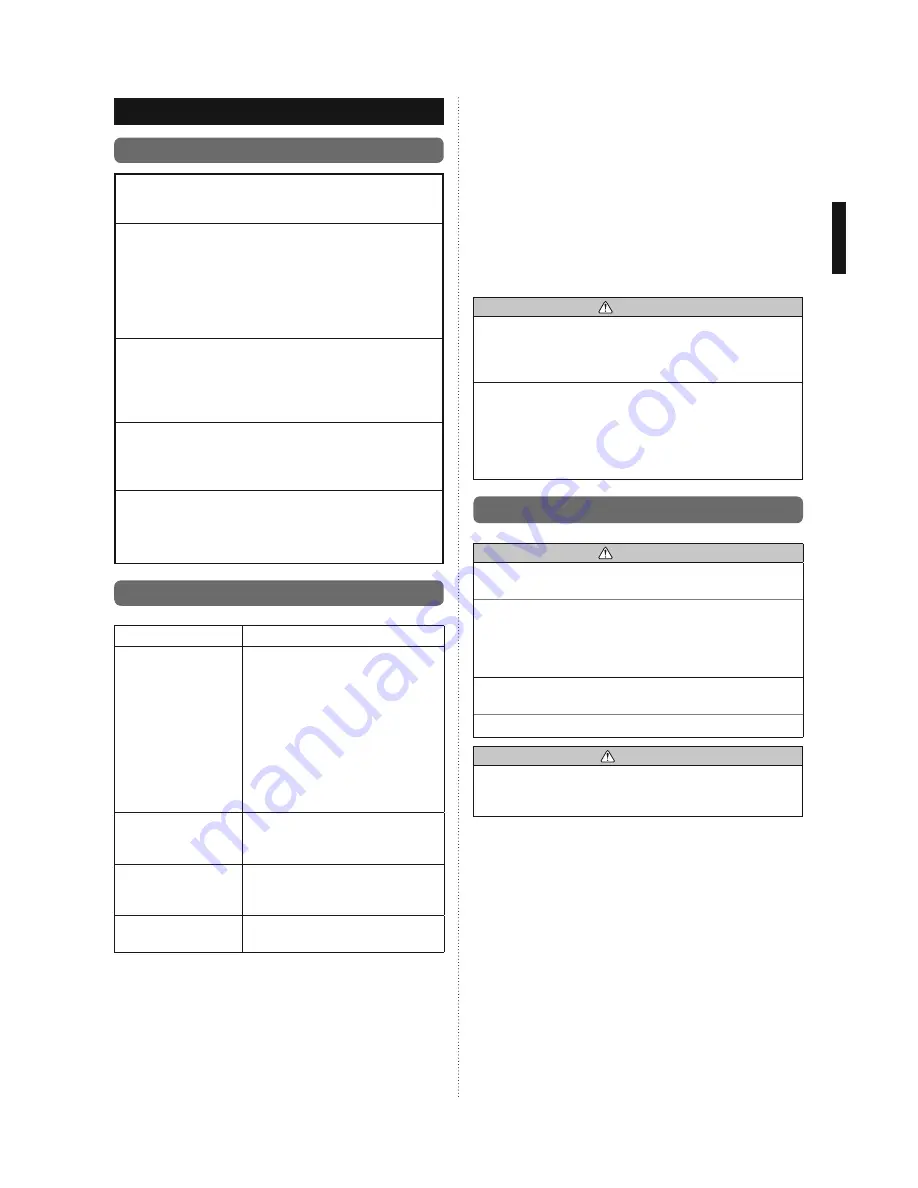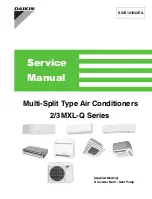
En-3
2. ABOUT THE UNIT
1
2.1. Precautions for using R410A refrigerant
The basic installation work procedures are the same as
conventional refrigerant (R22) models.
However, pay careful attention to the following points:
•
Since the working pressure is 1.6 times higher than that of
conventional refrigerant (R22) models, some of the piping and
installation and service tools are special. (See the table below.)
Especially, when replacing a conventional refrigerant
(R22) model with a new refrigerant R410A model, always
replace the conventional piping and flare nuts with the
R410A piping and flare nuts.
•
Models that use refrigerant R410A have a different charging
port thread diameter to prevent erroneous charging with
conventional refrigerant (R22) and for safety. Therefore,
check beforehand. [The charging port thread diameter for
R410A is 1/2 inch.]
•
Be more careful that foreign matter (oil, water, etc.) does
not enter the piping than with refrigerant (R22) models.
Also, when storing the piping, securely seal the opening
by pinching, taping, etc.
•
When charging the refrigerant, take into account the slight
change in the composition of the gas and liquid phases, and
always charge from the liquid phase side whose composition
is stable.
1
2.2. Special tools for R410A
Tool name
Contents of change
Gauge manifold
Pressure is high and cannot be
measured with a conventional
g a u g e . To p r e v e n t e r r o n e o u s
mixing of other refrigerants, the
diameter of each port has been
changed.
It is recommended the gauge with
seals 30 in. Hg to 768 psi for high
pressure.
30 in. Hg to 551 psi for low pres-
sure.
Charge hose
To increase pressure resistance,
the hose material and base size
were changed.
Vacuum pump
A conventional vacuum pump can
be used by installing a vacuum
pump adapter.
Gas leakage detector
Special gas leakage detector for
HFC refrigerant R410A.
Copper pipes
It is necessary to use seamless copper pipes and it is desirable that
the amount of residual oil is less than 0.0014 oz/10 m (33 ft). Do
not use copper pipes having a collapsed, deformed or discolored
portion (especially on the interior surface). Otherwise, the expansion
value or capillary tube may become blocked with contaminants.
As an air conditioner using R410A incurs pressure higher than
when using R22, it is necessary to choose adequate materials.
Thicknesses of copper pipes used with R410A are as shown
in the table. Never use copper pipes thinner than that in the
table even when it is available on the market.
WARNING
Do not use the existing (for R22) piping and flare nuts.
• If the existing materials are used, the pressure inside
the refrigerant cycle will rise and cause failure, injury,
etc. (Use the special R410A materials.)
When installing and relocating the air conditioner,
do not mix gases other than the specified refrigerant
(R410A) to enter the refrigerant cycle.
• If air or other gas enters the refrigerant cycle, the
pressure inside the cycle will rise to an abnormally
high value and cause failure, injury, etc.
2.3. For authorized service personnel only.
WARNING
For the air conditioner to operate satisfactorily, install it as
outlined in this installation manual.
Connect the indoor unit and outdoor unit with the air
conditioner piping and cords available from your local
distributor. This installation manual describes the correct
connections using the installation set available from your local
distributor.
Installation work must be performed in accordance with
national wiring standards by authorized personnel only.
Do not turn on the power until all installation work is complete.
CAUTION
This installation manual describes how to install the in-
door unit only. To install the outdoor unit, refer to the in-
stallation manual included with the outdoor unit.
• Be careful not to scratch the air conditioner when handling
it.
• After installation, explain correct operation to the customer,
using the operating manual.




































